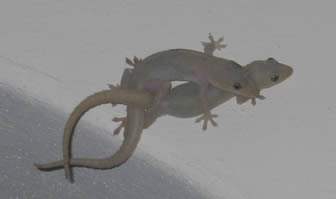Gecko lizard

The gecko lizard is reptile belonging to the family Gekkonidae. This family contains five subfamilies: Aeluroscalabotinae, Diplodactylinae, Eublepharinae, Gekkoninae and Teratoscincinae.
Gecko lizards inhabit warm regions in many different parts of the world. Some species of Gecko lizard are parthenogenic, which means that the female Gecko lizard can produce offspring on her own without mating with a male Gecko lizard. This has made it easier for such species to colonise islands and other forms of inaccessible regions. Gecko lizards are famous for the chirping sounds that they use to communicate with other Gecko lizards. This type of vocalization is not found in any other type of lizard.
Geckos feed on insects and/or fruit. Several types of lizard are popular as pets, especially the Leopard gecko (Eublepharis macularius). This gecko has claws instead of toe pads and can therefore not climb out of a glass terrarium. Before you get a Gecko pet you should always research that particular species since their requirements can vary. Also make sure that you are not purchasing a wild caught, endangered gecko species.
In warm parts of the world, people usually have Gecko lizards indoor more or less automatically, since several Gecko lizard species appreciate human dwellings and the insects that are attracted to our homes. They are usually appreciated boarders since they keep insects and other pests in check by eating them. One Gecko lizard species, Hemidactylus frenatus, is even named House Gecko in English.
Compared to other lizards, the gecko lizards are small or medium sized. A majority of the Gecko lizard species displays a tan to dark grey coloration and is decorated with a faint pattern. They can sometime look a bit rubbery. Some Gecko lizard species have an astonishing capability of blending into their surroundings by adjusting their coloration, while others can change colour according to temperature. A few Gecko lizards, such as the Tokay gecko and the Gargoyle gecko, have bright and flamboyant colour patterns.
Many Gecko lizard species have a fascinating habit of running around upside down and they have no problem attaching themselves to indoor ceilings. They can do this since they are equipped with specialized toe pads capable of creating so called van der Waals interactions. The reactions take place between the surface and the finely divided setae on the toe pad. Scientists are currently giving the Gecko lizard a lot of attention since they hope to be able to mimic the animals’ ability to climb. Gecko lizards can stick to a surface without having to relay on liquids or gases, and scientists hope to create a synthetic setae that would make it possible for human boots to stick to a surface in the same way. Such boots could for instance be used on Space Stations.
Examples of commonly known gecko lizard species are Crested gecko (Rhacodactylus ciliatus), Fox gecko (Hemidactylus garnoti), Gargoyle gecko (Rhacodactylus auriculatus), Golden gecko (Gekko ulikovski), House gecko (Hemidactylus frenatus), Leachianus Giant gecko (Rhacodactylus leachianus), Leopard gecko (Eublepharis macularius), Mediterranean gecko (Hemidactylus turcicus), Moorish gecko (Tarentola mauritanica), Mourning gecko (Lepidodactylus lugubris), Tree gecko (Hemiphyllodactylus typus) and Tokay gecko (Gekko Gecko).
